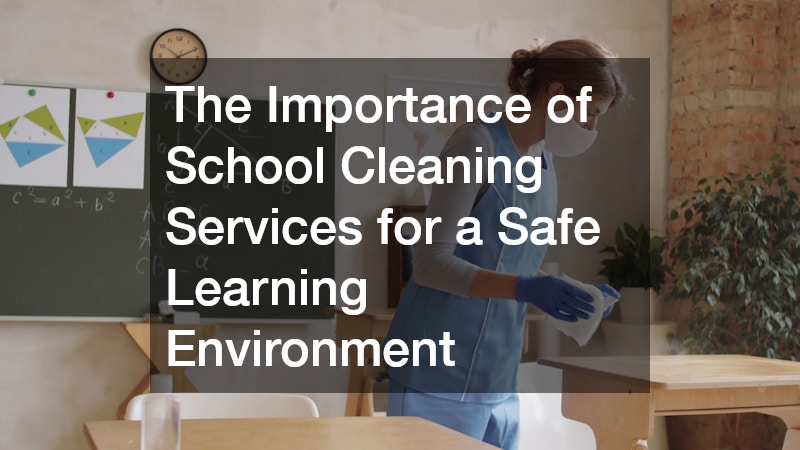
In the ever-evolving landscape of education, maintaining a safe and healthy learning environment is paramount. Schools are environments where large groups of students and staff gather daily, creating a unique ecosystem that requires meticulous attention to cleanliness. This piece explores the critical role of school cleaning services in fostering a conducive atmosphere for both students and educators, emphasizing their impact on health, performance, and school reputation.
Why is School Cleaning Essential?
School cleaning services are crucial because they play a vital role in preventing the spread of contagious illnesses. With students and staff constantly interacting, germs can spread rapidly, leading to widespread illness and increased absenteeism.
By prioritizing cleanliness, schools can ensure a safer environment, which is essential for uninterrupted learning.
Additionally, schools that invest in regular cleaning regimes help to minimize the risk of injuries and accidents, further ensuring student safety. Clean floors and walkways prevent slips and falls, especially in high-traffic areas. The use of appropriate cleaning solutions also ensures that toxic chemicals are kept at bay, safeguarding the health of everyone on campus.
Furthermore, a clean school environment helps to instill good hygiene habits in students. These habits, learned early on, can last a lifetime, positively influencing personal health and well-being. By doing so, schools not only protect current populations but also contribute to healthier communities in the future.
The cleanliness of a school can have a direct impact on student concentration and performance. A clean and organized learning environment minimizes distractions, allowing students to focus better on their studies. It also creates an atmosphere of respect and responsibility, encouraging students to take pride in their surroundings.
Studies have shown that students tend to perform better in environments that are free of clutter and dirt. Symptoms such as allergies or respiratory issues, often triggered by dust and mold, can negatively impact student health and, consequently, academic performance. Therefore, investing in thorough cleaning services can foster an environment where students feel both comfortable and motivated to succeed.
What are the Best Practices for School Cleaning?
Establishing regular cleaning schedules is crucial for maintaining hygiene standards in schools. Consistent routines ensure that all areas, from classrooms to restrooms, receive the attention they need to remain clean and safe. These schedules often involve daily, weekly, and monthly tasks tailored to the specific needs of each area.
A well-structured cleaning schedule can also help in efficiently allocating resources and managing staff workloads. By following a systematic cleaning plan, schools can ensure that areas are not overlooked, thus maintaining a consistently clean environment. Regular schedules also anticipate seasonal challenges, such as flu outbreaks, by increasing the frequency of cleaning when necessary.
Effective disinfection techniques are essential in eliminating germs and bacteria, particularly in high-contact areas like door handles, desks, and electronic devices. Schools should utilize EPA-approved disinfectants that are effective against a broad spectrum of pathogens, including viruses and bacteria. By doing so, they ensure a safer environment, reducing the risk of infection among students and staff.
Additionally, modern disinfection techniques, such as electrostatic spraying and UV light technology, can enhance the effectiveness of traditional methods. These advanced techniques can cover large areas swiftly and thoroughly, ensuring all surfaces are sanitized. By integrating these techniques, schools can achieve a higher standard of cleanliness that keeps up with contemporary health challenges.
How to Choose the Right School Cleaning Service?
When selecting a school cleaning service, it’s essential to evaluate potential providers based on a set of clearly defined criteria. Schools should assess the experience, reputation, and range of services offered by each provider. A provider with a proven track record in handling academic institutions is likely to better understand the unique challenges of a school environment.
Moreover, references and reviews can offer valuable insights into the reliability and quality of a cleaning service. Schools should look for providers that come highly recommended by similar institutions and have a history of satisfaction among their clients. Vetting potential providers thoroughly ensures that the chosen service aligns with the school’s standards and expectations for cleanliness.
Additionally, evaluating a service provider’s approach to training and staff management is crucial. Providers that prioritize ongoing staff education and supervision are more likely to deliver consistent results. This emphasis on quality control ensures that the cleaning standards set by the school are met without compromise.
School cleaning services are foundational to creating a safe, healthy, and conducive learning environment. They play a critical role in preventing illness, enhancing student performance, and strengthening school reputation. By adopting best practices, selecting the right service providers, and valuing stakeholder feedback, schools can ensure that cleanliness remains a top priority, supporting the overall well-being of students and staff.





